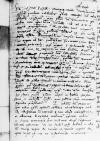Ventilantur nobiscum quidam rumores, quibus tametsi non adeo fidendum existimem, non potui tamen praetermittere, quin habito tam opportuno nuntio ea ad Reverendissimam Dominationem Vestram paucis perscriberem. Referunt (vel nugantur) mercatores ⌊regem Galliarum⌋ exercitu ex 50 milibus hominum collecto ⌊Francofordiam⌋ versus ducere vocantibus regem ad hoc quibusdam ⌊Germaniae⌋ (sive Germaniarum) principibus, qui negant serenissimum ⌊Ferdinandum regem Romanorum⌋ etc. rite et canonice (ut ioco dicam) in regem Romanorum electum, ita ut proximis litteris ⌊lantgrabii Hassiae⌋ et ⌊Ulrici ducis Wirtenbergensis⌋, quibus eum ducatum repetundarum iure extorquere nituntur, minime dignati serenissimum Ferdinandum Romanorum regis titulo <nuncupare>. ⌊Lantgrabium⌋ quoque referunt viginti milia hominum suae, id est egenwillicae(!)[1], factionis collegisse, quibus ⌊ducatum Wirtenbergensem⌋ honesto, ut putat, praetextu invadere instituit. Non desunt, qui existiment praecipuum huius labyrinthi architectum esse ⌊Galliarum regem⌋, nam constat ⌊lantgrabium⌋ bis clam, semel palam nuper in ⌊Gallia⌋ fuisse. Nam et militibus ⌊Hessi⌋ auro Gallico sive coronatis stipendia persolvuntur.
⌊Lubicenses⌋ nostri, nam et ipsi eodem spiritu aguntur, collectis tumultuariis militibus ⌊Holsaciam⌋ invaserunt et iam aliquot monasteria et abbatias diripuisse traduntur. Cogitant audaci, ne dicam temerario hoc instituto ⌊regem Cristiernum⌋ libertati restituere, ut is tandem opibus ⌊Lubicensium⌋ et aliorum utrique regno et ⌊Sueciae⌋ et ⌊Daniae⌋ negotium facessat. Visum est eis eo instrumento iniurias  BK, 230, p. 272 ab ⌊utroque illis regno⌋ illatas strenue vindicare posse.
BK, 230, p. 272 ab ⌊utroque illis regno⌋ illatas strenue vindicare posse.
Nec pacatiora ex ⌊Anglia⌋ nuntiantur. Nam et illic terra et mari bellum apparari dicitur, incertum quo instituto coacti sunt et omnes status eius ⌊regni⌋ novo homagio et iure iurando fidem suam obstringere non modo ⌊regi⌋, sed etiam heredibus ex ⌊regina⌋ nuper sibi ascita futuris. Ita
cf. Verg. G. 1.511 saevit toto Mars impius orbe ⌊toto saevit ⌊Mars⌋ impius orbecf. Verg. G. 1.511 saevit toto Mars impius orbe ⌋
.
Si Reverendissima Dominatio Vestra quid habeat ex aula ⌊caesaris⌋ de rebus Turcicis in ⌊Peloponesso⌋, tum in ⌊Hungaria⌋, praeterea si ⌊sanctissimus⌋ in Christo pro sua modestia patiatur adhuc ⌊Italiam⌋ quiete et tranquillitate frui etc., Insuper rogo non gravabitur Reverendissima Dominatio Vestra illud amico impartire.
Insuper rem mihi gratissimam fecerit Reverendissima Dominatio Vestra, si per commoditatem
cf. Mart. 12.43.3–5 Quales nec Didymi sciunt puellae, / Nec molles Elephantidos libelli, / Sunt illic Veneris novae figurae; Priapea 4 Obscenas rigido deo tabellas / dicans ex Elephantidos libellis / dat donum Lalage rogatque, temptes, / si pictas opus edat ad figuras.; Suet. Tib. 43.2.1-5 Cubicula plurifariam disposita tabellis ac sigillis lascivissimarum picturarum et figurarum adornavit librisque Elephantidis instruxit, ne cui in opera edenda exemplar impe[t]ratae schemae deesset. ⌊⌊Elephantidos⌋ libelloscf. Mart. 12.43.3–5 Quales nec Didymi sciunt puellae, / Nec molles Elephantidos libelli, / Sunt illic Veneris novae figurae; Priapea 4 Obscenas rigido deo tabellas / dicans ex Elephantidos libellis / dat donum Lalage rogatque, temptes, / si pictas opus edat ad figuras.; Suet. Tib. 43.2.1-5 Cubicula plurifariam disposita tabellis ac sigillis lascivissimarum picturarum et figurarum adornavit librisque Elephantidis instruxit, ne cui in opera edenda exemplar impe[t]ratae schemae deesset. ⌋[2] certo nuntio bene obsignatos ad me transmiserit, ut cum mea pictura eos conferre possum. Non quidem usui mihi futura ad praxim, sed versabor in eis veluti cum ideis speculative tantum, ut aiunt zophistae, et abstractive a materia et omni realitate etc. Has nugas dignabitur Reverendissima Dominatio Vestra boni consulere et me solita gratia et favore prosequi.
Cui me iterum atque iterum commendo.
 BK, 230, p. 272 ab
BK, 230, p. 272 ab 

